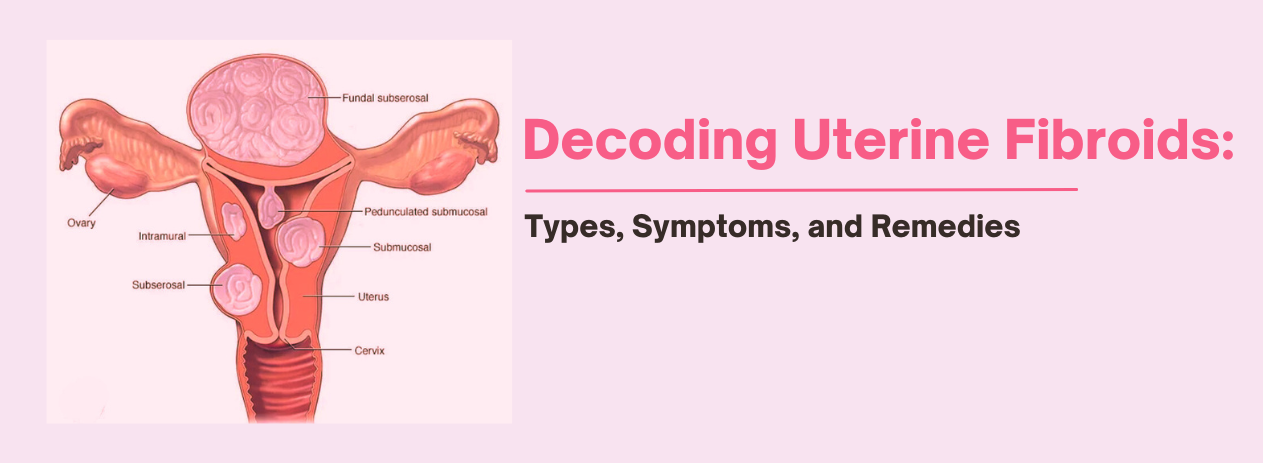| Decoding Uterine Fibroids: Types, Symptoms, and Remedies

Menstruation can turn into a challenging time, particularly if you have pelvic discomfort or excessive bleeding. However, you need to see a gynecologist if these symptoms worsen. Uterine fibroids may be the cause of the discomfort and bleeding.
Your uterus may develop leiomyomas, also known as uterine fibroids, which are non-cancerous growths. They generally show up while you are of reproductive age and come in a variety of sizes. Many women who have fibroids don't exhibit any symptoms at all.
What are Symptoms of Uterine Fibroids
➢ Heavy and painful bleeding during menstruation
➢ Back and leg ache
➢ Menstrual periods lasting longer
➢ Frequent urination
➢ Constipation
➢ Pain in the pelvic area
➢ Enlargement in your abdominal area
Types of Fibroid
Depending on where they are located on or within the uterus, fibroids can be classified into
many categories.
Subserosal Fibroids:
One typical kind of fibroid that develops outside of the uterus is called a subserosal fibrody. They could get huge and enlarge one side of your uterus. They don't create many problems with the reproductive system since they originate on the outside of
the uterus. However, you can feel a heavy feeling in your abdomen and have frequent urination if you have subserosal fibroids.
Inside-the-body Fibroids (Intramural Fibroids)
They develop in the uterine wall underneath the endometrium. They can alter the uterus's function depending on where they
develop and apply pressure. Long, heavy periods, frequent urination, and heavy periods are all signs of intramural fibroids.
Pedunculated Fibroids:
Noncancerous growths in the uterus are called pedunculated fibroids. A peduncle—a development that resembles a stalk—attaches them to the uterine wall. Abdominal discomfort, severe pain, such as cramping, and extended menstrual flow
are typical signs of pedunculated fibroids.
Under the skin Fibroids (Submucosal Fibroids)
These fibroids are the most uncommon and challenging to treat. They develop beneath the endometrium, the lining of the uterus, and can cause problems with periods and fertility. One to two percent of instances of infertility worldwide are caused by submucosal fibroids.
What Causes Uterine Fibroids?
It is unknown what specifically causes uterine fibroids. However, this state can be influenced
by extracellular matrix, hormones, and genetics.
According to studies, women of African descent are more likely to develop uterine fibroids.
Another important factor in developing this illness is heredity. Red meat and alcohol use may
also raise the risk of fibroids.
How to Treat Uterine Fibroids
In addition to a pelvic examination, uterine fibroids can be identified via MRI, hysterosonography, hysterosalpingography, hysteroscopy, lab testing, and ultrasound. It is advised that you wait for the fibroids to disappear on their own, which often occurs around menopause, if your symptoms are modest. Additionally, medications aid in the
management of this illness.
Management of Uterine Fibroids via Homeopathy
With the goal of treating the underlying causes and reducing symptoms, homeopathy provides a comprehensive approach to controlling uterine fibroids. A person's particular symptoms, mental condition, and general health are taken into consideration while choosing homeopathic treatments. The following are a few popular homeopathic treatments for uterine fibroids:
➢ Thuja Occidentalis
When there are several fibroids, especially if they are painful and firm, this treatment is frequently recommended. People who are emotionally sensitive and feel cold could find it appropriate.
➢ Calcarea Carbonica
People who use this medicine frequently feel coldness, exhaustion, and heavy menstrual flow. Those with fibroids in obese women or those who have experienced excessive menstrual bleeding in the past will find it very helpful.
➢ Sabina
Women with uterine fibroids who suffer with severe bleeding, bright red blood, and clots might benefit from Sabina. Pain that radiates from the lower back to the pubic region may also be a sign.
➢ Lachesis
For women with uterine fibroids whose symptoms intensify before to menstruation, this treatment is frequently recommended. In addition, they could experience powerful emotions or jealousy, as well as heat flashes.
➢ Sepia
Women with fibroids who feel agitated, worn out, and uninterested in their families are recommended to undergo sepsis. It could also be helpful for people who have a prolapse propensity and a dragging feeling in the pelvic area.
➢ Aurum Metallicum
If a woman has fibroids and feels overwhelmed, nervous, or sad, this cure could assist. It is especially recommended when there is a feeling of fullness and weight in the pelvic region.
➢ Maydis Ustilago
Women with fibroids who have irregular periods and black, clotted blood are advised to take Ustilago Maydis. It could also aid in reducing the discomfort and congestion associated with the pelvis.
Consulting a skilled homeopathic practitioner is essential for customized treatment. Individualization is the cornerstone of homeopathy, wherein the course of therapy is tailored to the unique symptoms and constitution of each patient.
